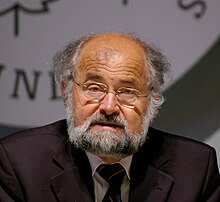Erwin Neher
Erwin Neher (Landsberg am Lech, 20 de marzo de 1944) estudió Física en la Universidad Técnica de Múnich. De origen judío, en Estados Unidos se especializó en Fisiología. Trabajó como investigador en las universidades de Wisconsin y Yale. En 1983 fue nombrado director del departamento de membranas del Instituto Max Plank de Gotinga.
El Dr. Erwin Neher investiga los principios biofísicos y moleculares del flujo de información entre neuronas, clave para el Parkinson y el Alzheimer.
En los años 70 Neher y Sakmann desarrollaron técnicas, llamadas Patch-clamp, que permiten medir el flujo de iones a través de los canales de membrana celulares.[1]
Recibió el Premio Nobel de Fisiología o Medicina el 7 de octubre de 1991 junto con Bert Sakmann.
En 2012 recibió el título de Doctor honoris causa por la Universidad de Valparaíso, Chile.[2]
Premios y Honores
[editar]- Premio Nobel de Fisiología o Medicina (1991, junto con Bert Sakmann)
- Miembro de la Royal Society (1994)[3]
- Premio Ralph W. Gerard de Neurociencia (1991)
- Premio Gottfried Wilhelm Leibniz (1987)[4]
- Premio Louisa Gross Horwitz (1986)[5]
Véase también
[editar]Referencias
[editar]- ↑ «Neher, Erwin – Real Academia Nacional de Farmacia». Consultado el 21 de junio de 2021.
- ↑ «Premio Nobel Erwin Neher recibió grado de Doctor Honoris Causa por la Universidad de Valparaíso». Universidad de Valparaíso. 29 de noviembre de 2012. Consultado el 30 de marzo de 2018.
- ↑ «Erwin Neher | Royal Society». royalsociety.org (en inglés británico). Consultado el 1 de septiembre de 2021.
- ↑ «Leibniz-Preis». www.dfg.de (en deutsch). Consultado el 1 de septiembre de 2021.
- ↑ «Horwitz Prize Awardees». Columbia University Irving Medical Center (en inglés). 20 de junio de 2018. Consultado el 1 de septiembre de 2021.
Enlaces externos
[editar]- Autobiografía (inglés)
- Página de Erwin Neher en el Instituto Max Plank (enlace roto disponible en Internet Archive; véase el historial, la primera versión y la última).
- Bibliografía relacionada con Erwin Neher en el catálogo de la Biblioteca Nacional de Alemania.
- Autobiografía del Nobel Komitee
- Nobel Publikation en nobel-med Erwin Neher, inglés
| Predecesor: E. Donnall Thomas Joseph E. Murray |
1991 |
Sucesor: Edmond H. Fischer Edwin G. Krebs |
Text is available under the CC BY-SA 4.0 license; additional terms may apply.
Images, videos and audio are available under their respective licenses.


